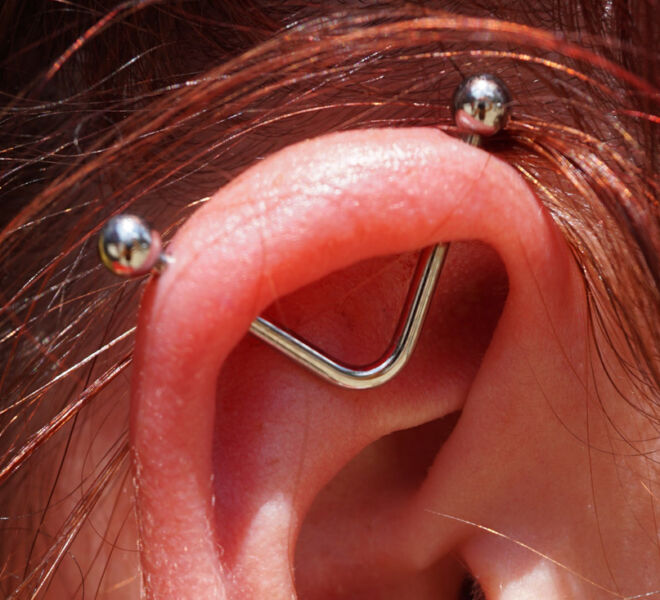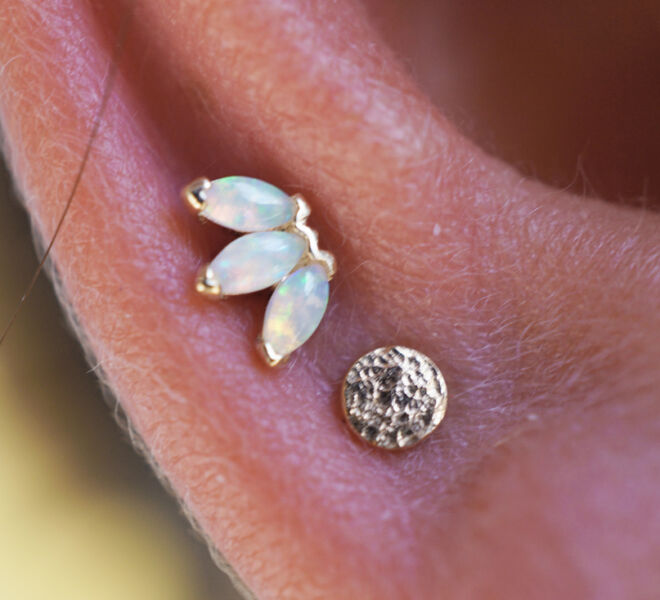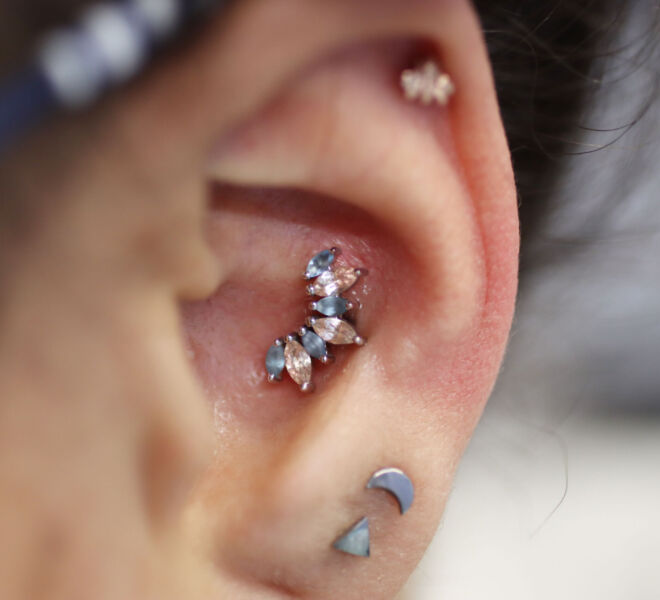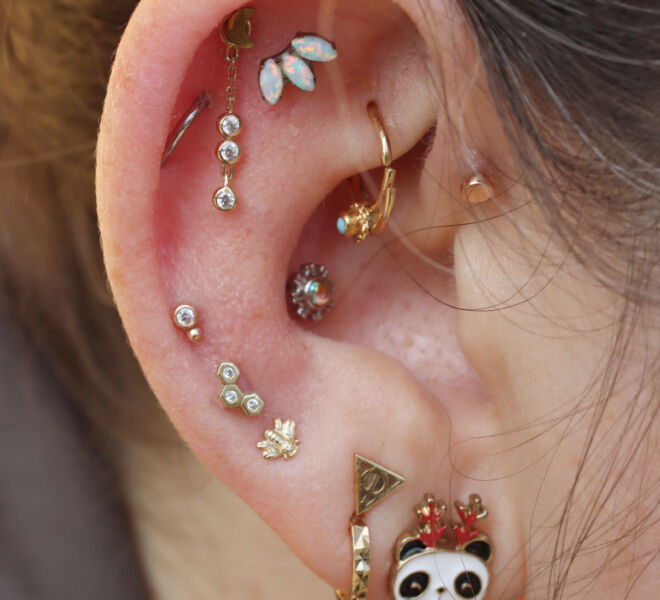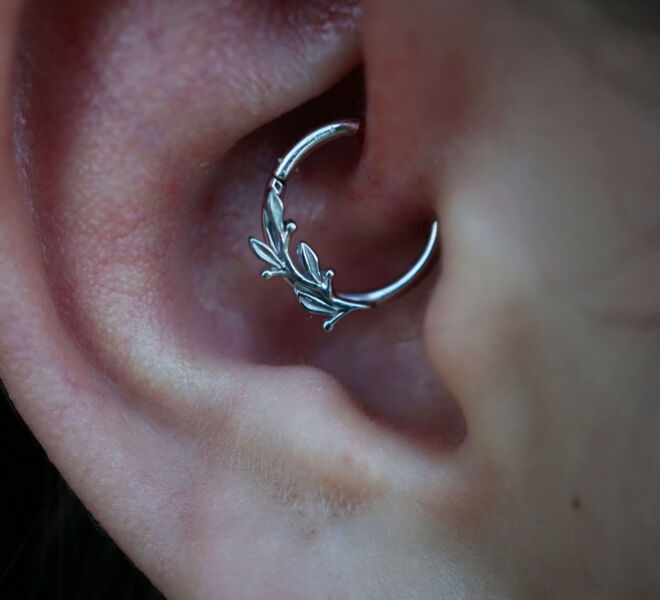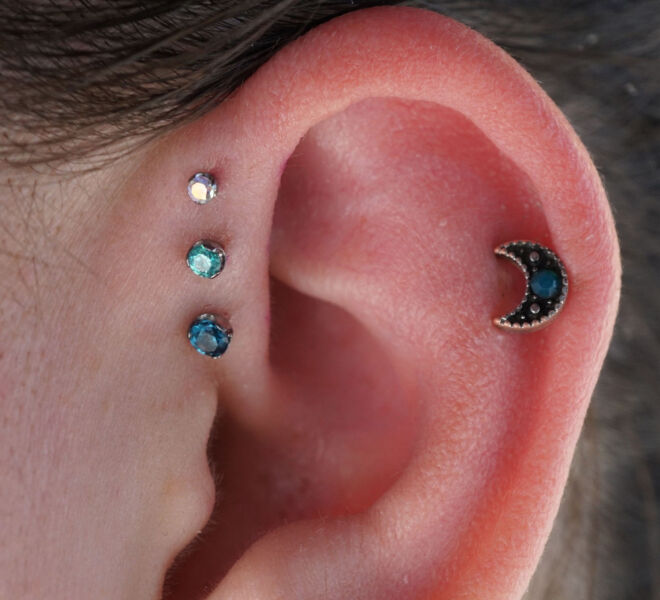PurSan was designed specifically for piercings and body art, and is the best aftercare cleanser we can recommend. If you have run out, please purchase more here, and we will ship it directly to you!
*Do not use any soaps that contain anti-bacterial properties, (Dove, Dial) or use chlorhexidine (Hibiclens), or tri-closan as an active ingredient.*
- At the end of your shower regimen, work a small amount of PurSan Body Art Cleanser into a lather and gently wash around the outside of the piercing.
- Rinse your piercing thoroughly under warm running water for 1 full minute.
This helps bring blood flow to the area, loosen crusties, and soap residue. - Pat the area dry with a clean paper towel or let the area air dry. – for hard to reach areas, such as the inside of your ear, use a hair dryer on a warm/cool setting.
For hard-to-soak locations including genitals, daiths, lobes, cartilage, rooks, forward helix, septums, surface piercings, and more.
- Saturate piercing site.
- Rinse off after 1 minute if extra dryness is seen, but rinsing off saline is not necessary.
- Pat the area dry with a clean paper towel or let the area air dry. – for hard to reach areas, such as the inside of your ear, use a hair dryer on a warm/cool setting.
PurSan was designed specifically for piercings and body art, and is the best aftercare cleanser we can recommend. If you have run out, please purchase more here, and we will ship it directly to you!
*Do not use any soaps that contain anti-bacterial properties, (Dove, Dial) or use chlorhexidine (Hibiclens), or tri-closan as an active ingredient.*
- At the end of your shower regimen, work a small amount of PurSan Body Art Cleanser into a lather and gently wash around the outside of the piercing (don’t get the soap into the piercing itself).
- Rinse your piercing thoroughly under warm running water for 1 full minute.
This helps bring blood flow to the area and removes crusties, and soap residue. - Gently rinse away any crusty material with either non-woven gauze or a clean paper towel, and pat the area dry. – for hard-to-reach areas, such as the inside of your ear, use a hair dryer on a warm/cool setting.
- Sleeping on your new piercing – especially with surface anchors, the added pressure can cause them to reject. Please ensure you do not sleep on your piercing.
- Dirty hands, or saliva touching your piercing before it is healed.
- Using a cleaning agent that can damage your piercing, such an an antibacterial soap, alcohol, peroxide, and the like.
- Improper aftercare routine, including stopping your aftercare routine before you are finished healing.
- “Playing” with jewelry before the piercing is healed.
- Wearing inferior quality jewelry or metals (i.e. materials which are not up to industry standards such as acrylic, or “surgical” steel.)
If you have any problem with healing we will be happy to help! We understand that since opening up in Columbus in 1994, people see us as the experts. We will help with piercings that we didn’t perform, however, understand we can only make suggestions, we are not physicians.
A physician must be contacted as soon as possible if a problem persists.
For your Surface Anchor aftercare routine, we recommend sea salt soaks once daily. This will help bring down swelling, soothes irritation, and brings blood flow back to the area.
- Mix 1 full container of H2Ocean Concentrate into 1 gallon of purified or distilled (not tap) water, and mix thoroughly.
- Portion solution into a small, clean vessel (enough to be able to fully submerge your piercing).
- Fully submerge your piercing for 10 minutes. After the total of 10 minutes, discard the used solution.
- Seal the un-used solution in an air tight container, and refrigerate until next use.
*Portion only the amount you need for each soak to a smaller, clean vessel each time, to avoid cross-contamination of the solution* - After the total of 10 minutes, thoroughly rinse your piercing with clean water, Gently brush away any crusty material with either non-woven gauze or a clean paper towel, and pat the area dry. – for hard to reach areas, such as the inside of your ear, use a hair dryer on a warm/cool setting until fully dry.
- Repeat steps 2 – 5, once daily.
- This container is good for up to 1 month. After 1 month, discard remaining solution and purchase a new container.
Because surface bar piercings have an entrance and exit point, they can be removed the same way any other piercing is. Surface anchor piercings are placed under the skin and have no exit point, their removal process is different. Care must be taken in removing these piercings and the removal of a surface piercing should only be done by a professional piercer.
Scaring after a piercing is removed, depends on how well the piercing was taken care of before and after the removal process. It is different for every person.
Surface anchors have a high rate of rejection. Your body can see the jewelry as a foreign object and slowly pushes it out of your skin as it would a splinter. These piercings can slowly migrate to the surface of the skin. Surface piercings will start to grow out, or reject, from the outer edges slowly towards the center of the jewelry.
Key signs of rejection are:
Redness, swelling, tenderness, and persistent gooey discharge. As well, if you notice one side of your surface anchor’s “foot” is raised more than the other, or if your piercing has a significant “tilt” to one side or another, your piercing may be rejecting. If you suspect your surface anchor is rejecting, please visit us for removal as soon as possible. The sooner we are able to remove it, the less severe your scarring will be. We will be happy to do so for you.
Following the correct aftercare will give you the best chance of your piercing being a part of your body for years.
If you have any questions or concerns regarding your piercings, please stop into the studio to see one of our qualified professional body piercers on staff to have us inspect your piercing, and give suggestions on how to continue in your care of your piercings! Happy healing!
- 4-6 -/+ weeks: Ear lobes
- 6-8 -/+ weeks: Cartilage, Navel, Nipples, Genitals
- 1-2 times, 10-21 -/+ days: Oral piercings
In an emergency, you can make your own saline solution to use for soaks.
- Step 1: Wash your hands thoroughly.
- Step 2: Dissolve 1/4 teaspoon of non-iodized sea salt into one cup (8 oz.) of distilled or bottled water. – Ensure your measurements are precise!
- Step 3: Microwave your solution for 30-60 seconds, or until it is warmer than body temperature.
Sea Salt Soak Tips:
- A stronger solution does not mean a better solution, or a quicker heal! Too much salt can actually cause more harm than good, such as dryness, itchiness, redness and irritation.
- Mix a new sea salt solution with every single cleaning. – Keeping your pre-made sea salt solution in a container for days can harbor bacteria, and is not advised.
- Do your sea salt soaks on opposite ends of the day to your cleaning, so you do not dry out your piercing. As well, ensure you aren’t doing them too few, or too many times a day! Moderation is key!
- Salt water, or sterile saline is the only additional product (other than the cleanser and water) we suggest you use to care for your piercing. – General rule of thumb: If you can’t put it in your eye, don’t put it in your piercing! (No tea tree oil, peroxide, alcohol, etc.)
Bleeding, bruising, discoloration and/or swelling is not uncommon with new piercings. These are not indications of any complication. Unless they persist after __ days.
Reduce intake of aspirin, alcohol, and caffeine, as these can increase your swelling. For above-the-neck piercings, try sleeping with your head elevated above your heart (prop up on some pillows) to limit overnight swelling.
Studies show non-steroidal anti-inflammatory products such as Ibuprofen (Advil, Motrin, etc.) can help minimize swelling.
Some tenderness, soreness or discomfort in the area of a new piercing is not unusual. You may feel stinging, burning, or aching on and off for several days or longer. During healing there may be some itching.
Secretion of a fluid which contains lymph and dead cells is perfectly normal.
This fluid is fairly liquid, and typically a whitish-yellow color, and forms a crust on the jewelry at the openings of the piercing. This is not pus, but indicates a healing piercing.
Once healed, your piercing may secrete a semi-solid white malodorous substance from the oil glands called sebum. This also is not pus, but indicates a healed piercing.
Piercings may have a tendency to have a series of “ups and downs” during healing by seeming healed, and then regressing. Try to be patient, and keep cleaning during the entire initial healing time, even if the piercing seems healed.
Tightness is normal. Do not expect jewelry to swing freely in most body piercings, even after they are thoroughly healed.
While we sometimes can pierce with hoops, we always make clear to our clients that hoops in a fresh piercing will have:
- Increased movement, causing more irritation within the piercing channel.
- Increased healing time due to increased irritation.
- Increased chances of irritation bumps to form due to increased irritation.
- Cannot be snug fitting; snug fitting hoops do not allow for swelling.
- Seam/continuous rings will not be used until the piercing is fully healed at about 1 year; where the ends of the ring meets i.e. the seam, will essentially tear through the piercing channel and not allow the piercing to heal.
- Rings must have a bead to prevent the ring moving through the piercing channel.
If your goal is a snug fitting hoop, we recommend starting with a stud and then switch to a hoop with a bead around 6 months, and a seam/continuous hoop once the piercing is fully healed at about 1 year.
| Oral Piercing | Average Minimum Healing Times |
|---|---|
| Tongue | 2 - 3 months (+) |
| Lip | 3 - 5 months (+) |
| Philtrum | 3 - 5 months (+) |
| Labret | 3 - 4 months (+) |
| Monroe | 3 - 4 months (+) |
| Vertical Labret | 4 - 5 months (+) |
| Gential Piercing(s) | Average Minimum Healing Times |
|---|---|
| Vertical/Horizontal Clitoral Hood | 2 - 3 months (+) |
| Inner Labia | 2 - 3 months (+) |
| Outer Labia | 3 - 5 months (+) |
| Forchette | 3 - 4 months (+) |
| Christina (Pubic Mound) | 4 - 6 months (+) |
| Prince Albert | 2 - 3 months (+) |
| Scrotum/Hafada | 2 - 3 months (+) |
| Apadravya | 4 - 5 months (+) |
| Ampallang | 4 - 5 months (+) |
| Guiche | 3 - 4 months (+) |
| Body/Ear Piercing | Average Minimum Healing Times |
|---|---|
| Ear Lobe | 2 - 4 months (+) |
| Ear Cartilage | 3 - 4 months (+) |
| Daith | 4 - 5 months (+) |
| Forward Helix | 3 - 4 months (+) |
| Conch | 4 - 5 months (+) |
| Tragus | 3 - 4 months (+) |
| Rook | 3 - 4 months (+) |
| Nostril | 3 - 4 months (+) |
| Eyebrow | 2 - 3 months (+) |
| Septum | 2 - 3 months (+) |
| Industrial/Snug/Ear Project | 6 - 12 months (+) |
| Navel | 4 - 6 months (+) |
| Nipple | 4 - 6 months (+) |
| Orbital | 6 - 12 months (+) |
| Surface Anchor | 3 - 4 months (+) |
| Surface Bar | 6 - 12 months (+) |


